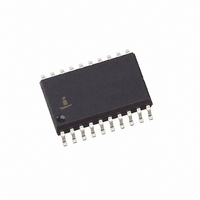HD9P6409-9Z96 Intersil, HD9P6409-9Z96 Datasheet - Page 6

HD9P6409-9Z96
Manufacturer Part Number
HD9P6409-9Z96
Description
IC MED MANCHESTER 1MHZ 20-SOIC
Manufacturer
Intersil
Type
Manchester Encoder/Decoderr
Datasheet
1.HD3-6409-9Z.pdf
(14 pages)
Specifications of HD9P6409-9Z96
Applications
Security
Mounting Type
Surface Mount
Package / Case
20-SOIC (7.5mm Width)
Lead Free Status / RoHS Status
Lead free / RoHS Compliant
Available stocks
Company
Part Number
Manufacturer
Quantity
Price
Part Number:
HD9P6409-9Z96
Manufacturer:
INTERSIL
Quantity:
20 000
Crystal Oscillator Mode
Manchester Code
Nonreturn-to-Zero (NRZ) code represents the binary values
logic-O and Iogic-1 with a static level maintained throughout
the data cell. In contrast, Manchester code represents data
with a level transition in the middle of the data cell.
Manchester has bandwidth, error detection, and
synchronization advantages over NRZ code.
The Manchester II code Bipolar One and Bipolar Zero shown
below are logical complements. The direction of the
transition indicates the binary value of data. A logic-0 in
Bipolar One is defined as a Low to high transition in the
middle of the data cell, and a logic-1 as a high to low mid bit
transition, Manchester Il is also known as Biphase-L code.
The bandwidth of NRZ is from DC to the clock frequency fc/2,
while that of Manchester is from fc/2 to fc. Thus, Manchester
can be AC or transformer coupled, which has considerable
advantages over DC coupling. Also, the ratio of maximum to
minimum frequency of Manchester extends one octave, while
the ratio for NRZ is the range of 5 to 10 octaves. It is much
easier to design a narrow band than a wideband amp.
Secondly, the mid bit transition in each data cell provides the
code with an effective error detection scheme. If noise
produces a logic inversion in the data cell such that there is
no transition, an error indiction is given, and synchronization
C1
C1
C0
FIGURE 5. CRYSTAL OSCILLATOR MODE
R1
16MHz
X1
6
O
C
I
X
O
X
C1 = 32pF
C0 = CRYSTAL + STRAY
X1 = AT CUT PARALLEL
R
R1 = 15MΩ
BIPOLAR ZERO
S
BINARY CODE
BIPOLAR ONE
NONRETURN
(TYP) = 30Ω
BIT PERIOD
RESONANCE
FUNDAMENTAL
MODE
TO ZERO
FIGURE 4. MANCHESTER CODE
HD-6409
HD-6409
1
0
2
1
LC Oscillator Mode
must be re-established. This places relatively stringent
requirements on the incoming data.
The synchronization advantages of using the HD-6409 and
Manchester code are several fold. One is that Manchester is
a self clocking code. The clock in serial data communication
defines the position of each data cell. Non self clocking
codes, as NRZ, often require an extra clock wire or clock
track (in magnetic recording). Further, there can be a phase
variation between the clock and data track. Crosstalk
between the two may be a problem. In Manchester, the
serial data stream contains both the clock and the data, with
the position of the mid bit transition representing the clock,
and the direction of the transition representing data. There is
no phase variation between the clock and the data.
A second synchronization advantage is a result of the
number of transitions in the data. The decoder
resynchronizes on each transition, or at least once every
data cell. In contrast, receivers using NRZ, which does not
necessarily have transitions, must resynchronize on frame
bit transitions, which occur far less often, usually on a
character basis. This more frequent resynchronization
eliminates the cumulative effect of errors over successive
data cells. A final synchronization advantage concerns the
HD-6409’s sync pulse used to initiate synchronization. This
three bit wide pattern is sufficiently distinct from Manchester
data that a false start by the receiver is unlikely.
3
1
4
0
FIGURE 6. LC OSCILLATOR MODE
C1
C1
5
0
L
O
I
X
X
C E
C1 = 20pF
C0 = 5pF
f
O
≈
≈
C1 2C0
------------------------- -
---------------------- -
2π LC
–
1
2
e
October 15, 2008
FN2951.3














